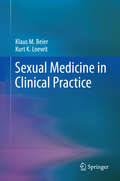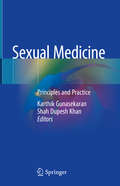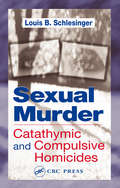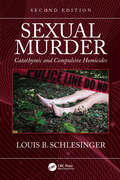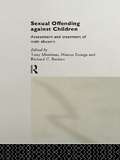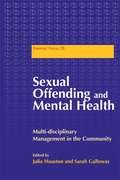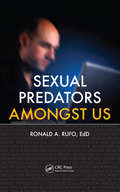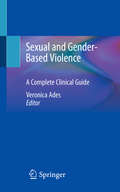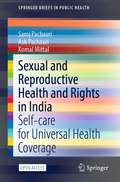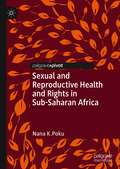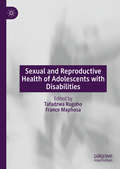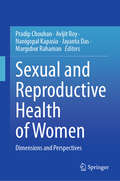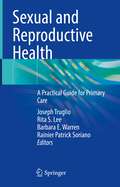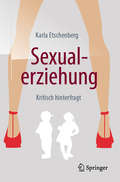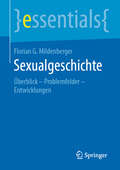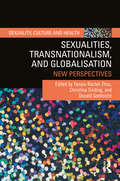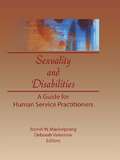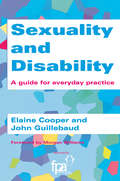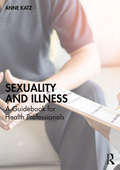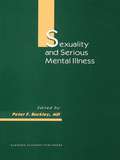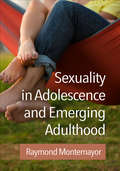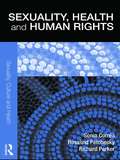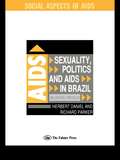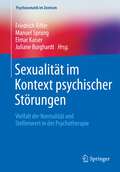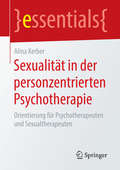- Table View
- List View
Sexual Medicine in Clinical Practice
by Kurt K. Loewit Klaus M. BeierCall it a remnant of our Victorian past, but sexual concerns lag behind other aspects of health, both in the training of physicians and therapists and in the way they impart this knowledge to clients. But as sexuality gains recognition as crucial to one's quality of life, evidence-based methods of understanding and discussing sex are imperative--and not only in treating pathology. Sexual Medicine in Clinical Practice provides framework, rationale, and strategies for both approaching sexual problems and addressing patients' questions about sexual health, behavior, and relationships. Analyzing sexuality along three dimensions--attachment, reproduction, and desire--this concise manual offers a biopsychosocial lifespan model readily translatable into clinical work. This "syndyastic" framework integrates attachment and relational theory to reinforce the bond between intimacy and connectedness, and models nonjudgmental approaches to disorders of sexual function, maturity, preference, and behavior. The authors' salutogenic rather than pathogenic focus lets clients become major players in their own healing, and the therapist or doctor serve as expert and guide. Among the topics covered: The communicative function of sexuality. The spectrum of sexual disorders. Principles of diagnostics in sexual medicine. Disease-centered versus client-centered aspects of sexual therapy. Therapeutic approaches for sexual traumatization. New challenges, including preventing child sexual abuse and online sex crime. Plus case studies, interdisciplinary references, and ethical issues. A timely, perspective- and practice-altering volume, Sexual Medicine in Clinical Practice is essential reading for family and primary care physicians, family and sex therapists, health psychologists, and psychiatrists.
Sexual Medicine: Principles and Practice
by Karthik Gunasekaran Shah Dupesh KhanThough sexual medicine is probably among the oldest of medical specialties, in fact not much was spoken about the subject till Kinsey published his first report in 1948. Speaking of sex was not considered a taboo by ancient civilizations, but this has not continued into the modern era. Herein lies the principle problem...patients and even doctors are not willing to openly discuss sexuality and sexual health. Healthcare professionals also fail to discuss these pertinent issues due to a lack of time, resources and general fear of causing offense. More importantly, there seems to be a lack of good training. Societies like the International Society of Sexual Medicine and European Society of Sexual Medicine (ESSM) are actively taking up the cause and furthering research into this particular field. Considering that the prevalence of male and female sexual dysfunction in the general population ranges between 2 and 10%, the need of the hour is to train more doctors to professionally practice sexual medicine.Good textbooks on sexual medicine for primary healthcare providers are few and far between. The ESSM has come out with a working syllabus but a more concise text is still lacking. This book, Sexual Medicine – Principles and Practice, aims to bridge that gap by presenting scientific principles in the treatment of male and female sexual dysfunction, while also highlighting numerous recent advances. Reviewing basic principles like assessment of male and female sexual function and/or dysfunction, along with sex therapy, it offers an essential reference guide for physicians, surgeons, gynecologists, urologists, and all those wish to practice sexual medicine
Sexual Murder: Catathymic and Compulsive Homicides
by Louis B. SchlesingerForensic psychologist and author Louis B. Schlesinger delves deep into the minds of sexual murderers. It is a place where few dare to tread, but a necessary journey if we are to understand the motivations behind their inconceivable actions. Culminating nearly 30 years of experience analyzing sexually motivated homicides, Sexual Murder: Catathymic a
Sexual Murder: Catathymic and Compulsive Homicides
by Louis B. SchlesingerSexual Murder: Catathymic and Compulsive Homicides is the culmination of the author’s 45 years of experience with, and studying, sexually motivated homicide. Sexual murders are generally of two types — catathymic and compulsive. Catathymic homicides are caused by a breakthrough of underlying sexual conflicts. They can be unplanned, explosive (acute) attacks or planned murders stemming from a chronic obsession with, or disturbed attachment to, the victim. In compulsive homicides, a fusion of sex and aggression results in a powerful internal drive which pushes the offender to seek out victims to kill — and the killing itself is sexually gratifying. These murders also may be planned or unplanned. In compulsive homicides that are unplanned, the urge breaks through and disrupts the offender’s controls when a victim of opportunity crosses his path. The compulsive offender who plans his crimes often eludes law enforcement, and as a result he can have multiple (serial) victims over extended periods of time. Both forms of sexual murder — the catathymic and the compulsive — are presented in this volume from a clinical-descriptive perspective encompassing case studies with analysis. Recent advances in empirical research in sexual murder—including findings from the joint research project between John Jay College of Criminal Justice and the FBI Behavioral Analysis Unit in Quantico—has published many important studies. These include such topics as necrophilia, foreign object insertions in sexual homicide, ritual and signature and temporal patterns in serial sexual homicide, mass murder, crime scene staging in homicide, and undoing (symbolic reversal) at homicide scenes. All such research will be included and incorporate into this fully updated Second Edition, including approximately fifty new clinical case studies.
Sexual Offending Against Children: Assessment and Treatment of Male Abusers
by Marcus Erooga Tony Morrison Richard BeckettWritten by a multi-disciplinary group of leading practitioners, Sexual Offending Against Children provides an account of the practice, policy and management issues involved in the assessment and treatment of adult and adolescent sexual offenders against children. Written for practitioners from all disciplines concerned with this area of work, it is underpinned by a strong theoretical base, giving a practical and detailed description of the management of sexual offenders, as well as the potential impact on service providers.
Sexual Offending and Mental Health: Multidisciplinary Management in the Community
by Jackie Craissati Alison Beck Julia Houston Andrew Aboud Sarah GallowaySexual Offending and Mental Health draws together theoretical, clinical and mental health issues for the range of professionals working in the community and in-patient settings with sex offenders and those who have behaved in sexually inappropriate ways. The contributors describe current influential models of sexual offending and the developmental, psychological and social factors involved. They discuss the prevalence of personality and mental disorders in known sex offenders and the impact these disorders have on their treatment and management. They describe clinical work with individuals, their partners and families, and also consider the impact of this work on professionals. The book includes an outline of current approaches to risk assessment, an overview of the recent changes in legislation in England and Wales, and suggestions for multi-disciplinary management in the community. This book will be essential reading for professionals working in health or criminal justice settings with people who have committed sexual offences or whose sexual behaviour has caused concern for others.
Sexual Predators Amongst Us
by Ronald A. RufoIt is imperative that educators, parents, and potential victims be aware of sexual predators, the danger they pose in our society, and the resources available to help prevent this growing epidemic. Written from a police perspective, Sexual Predators Amongst Us examines the problem of sexual predation, how the Internet has contributed to its growth,
Sexual and Gender-Based Violence: A Complete Clinical Guide
by Veronica AdesThis book is an accessible guide to caring for survivors of sexual and gender-based violence (SGBV). Sexual violence is broadly defined in order to include sexual assault, but also often forgotten subjects such as female genital cutting, sex trafficking, and military sexual violence. The average practitioner, gynecologist or otherwise, will undoubtedly encounter a victim of some sexual violence during their time in practice and this guide is designed to answer all questions on how to approach, treat, and understand a survivor of sexual violence. Written by a multidisciplinary team of medical, psychological, and legal experts, the book is organized into four sections. The first section begins with a scholarly analysis of trauma and how to discuss that trauma with patients. The second section covers types of violence and populations at risk, including intimate partner violence, sex trafficking, and LGBTQ considerations. The third section provides critical focus on the examination procedure, providing strategies for speaking to survivors and conducting a sensitive medical examination. Within each of these chapters, the reader will find experts sharing their tips, best practices, and understandings of exactly how trauma affects care. The final section covers medicolegal legal issues, providing a basic introduction to general legal processes regarding sexual violence matters in the US in order to serve as a resource for any practitioner presented with legal questions by a patient. This book gives a comprehensive overview of clinical care for survivors of SGBV. The clinical focus of this book goes beyond emergency room and crisis intervention protocol described in other books and makes it an ideal guide for all general health practitioners treating this population.
Sexual and Reproductive Health and Rights in India: Self-care for Universal Health Coverage (SpringerBriefs in Public Health)
by Saroj Pachauri Ash Pachauri Komal MittalThis open access book addresses self-care on sexual and reproductive health and rights and HIV prevention and treatment in the most marginalized and vulnerable communities. Case studies and personal narratives are used to share their perspectives and experiences, sources of information for self-care products, motivations for self-care, and challenges and outcomes. Self-care provides the way to reach the last mile in achieving universal health coverage and the Sustainable Development Goals. Issues related to stigma, discrimination and violence among these communities are highlighted. Changes in policies and programs to improve their sexual and reproductive health, education and employment are discussed. The last chapter in the book examines how the agenda on self-care can be advanced in the years ahead. The audience for this publication includes health professionals, researchers, those managing health institutions and service providers.
Sexual and Reproductive Health and Rights in Sub-Saharan Africa (Global Research in Gender, Sexuality and Health)
by Nana K. PokuThis book provides a clear and detailed examination of why it is so difficult to secure comprehensive political engagement and actionable, effective policy on sexual and reproductive health rights in sub-Saharan Africa. In an engaging analysis, Nana Poku employs expert knowledge to examine the prospects for large-scale improvements. He explores not only the full range of normative sensitivities, but also conceptual misunderstandings, legal difficulties and complex challenges of securing and maintaining adequate funding while AIDS remains a pandemic in the region. Up-to-date, succinct yet highly detailed, lucid and compelling in its diagnoses of highly complex issues, this book is a valuable, accessible study of a topic that is regional in focus but with clear global implications.
Sexual and Reproductive Health of Adolescents with Disabilities
by Tafadzwa Rugoho France MaphosaThis book investigates various experiences of teaching sexual and reproductive health to adolescents with disabilities. Following the adoption of the UNCRPD, adolescents with disabilities still commonly suffer from widespread violation of their rights particularly concerning sexual and reproductive health – often being viewed as either asexual or hypersexual. Contemporary societies do not readily encourage the participation of these young people in conversations or decision making processes concerning their own sexual and reproductive health. This book delves into such complex issues, critically examining how global communities attempt to teach sexual and reproductive issues to adolescents with disabilities in the modern era.
Sexual and Reproductive Health of Women: Dimensions and Perspectives
by Jayanta Das Pradip Chouhan Avijit Roy Nanigopal Kapasia Margubur RahamanThe book offers readers a nuanced understanding of sexual and reproductive rights, health status, associated concerns and policy critiques within the context of South Asia. While sexual and reproductive health issues are prevalent worldwide, the severity and underlying drivers vary across regions. South Asia, identified as a hotspot for vulnerability in sexual and reproductive health, currently lacks comprehensive coverage of existing global perspectives on the subject. Intended as a comprehensive guide to understanding the sexual and reproductive health complexities, reproductive morbidity and multifaceted health policies of women in South Asia, this book will examine menstrual health as well as changing fertility behaviours among women. It will provide in-depth case studies on demand family planning, birth control and pressing issues of women’s health perspectives. The book highlights the wide range of sexual and reproductive health morbidities, including maternal health complications, eclamptic maternal death, sexually transmitted diseases, infected diseases and health disparity among reproductive women. Adopting advanced quantitative techniques in the social sciences and GIS modeling, this book offers a unique and insightful look at women’s reproductive health and its implications for shaping health policies.
Sexual and Reproductive Health: A Practical Guide for Primary Care
by Joseph Truglio Rita S. Lee Barbara E. Warren Rainier Patrick SorianoThis book is a point-of-care resource for effective sexual and reproductive healthcare for patients of all ages, sexual orientations, gender identities and medical backgrounds in the primary care setting. This useful guide is divided into three parts, and other than part three, which deals exclusively with transgender and gender diverse patients, all content will relate to patients of all gender identities. Part one presents sexual and reproductive health (SRH) using a lifespan approach, including chapters on pediatrics, adolescents and young adults, adults, and older adult patients. Part two presents an approach to common SRH issues that span multiple age groups, including contraception and family planning, sexually transmitted infections and cancer screenings as well as sexual and reproductive health in the setting of common medical conditions. Part three is dedicated to sexual and reproductive health for transgender and gender non-binary patients, including psychosocial, medical, surgical and legal aspects of health. This book provides primary care clinicians with a framework for providing effective sexual and reproductive healthcare to patients of all ages, sexual orientations and gender identities in a way that is inclusive, focuses on health, and addresses the needs unique to specific populations.
Sexualerziehung: Kritisch hinterfragt
by Karla EtschenbergSexualfreundliche Sexualerziehung soll und muss sein, aber wem nützt eine pro-aktiv sexualisierende Sexualerziehung und warum löst sie Widerstand aus? Ist die aktuell diskutierte Sexualpädagogik mit ihren Zielen und Methoden kindgerecht oder bedient sie Interessen von Erwachsenen? Diese Streitschrift bietet Interessierten und an Erziehung Beteiligten Informationen und Analysen, sowie persönliche Einschätzungen der Autorin, die nachdenklich machen. Das Buch reflektiert alternative Herangehensweisen an das Thema Sexualität in Kita und Schule und erklärt, warum sich religiös begründete und „moderne“ sexual-pädagogische Konzepte ähneln. Die Autorin nimmt die Leser mit in die Fragestellung und Besorgnis, ob die derzeit propagierte Sexualerziehung darauf hinausläuft, Kinder mit pädagogischer Legitimation in die sexualisierte Erwachsenenwelt hineinzuziehen. Es öffnet die Augen für die Thematik und gibt Hinweise wie Kinder und Jugendliche motiviert werden können, sich vor dem Einfluss von Pornografie zu schützen.
Sexualgeschichte: Überblick – Problemfelder – Entwicklungen (essentials)
by Florian G. MildenbergerDie Sexualgeschichte ist keine eigenständige Disziplin, sondern Teilaspekt natur-, geistes- und sozialwissenschaftlicher Fächer sowie häufiges Thema gesellschaftspolitischer Diskussionen. Florian G. Mildenberger zeigt historische Entwicklungen, gesellschaftliche Diskurse und Problemfelder von der Antike bis zur Gegenwart auf, beschreibt sie überblicksartig und stellt weitere Literatur für eigene Studien bereit.Der Autor:Dr. Florian G. Mildenberger ist Professor am Institut für Geschichte der Medizin der Robert Bosch Stiftung in Stuttgart und forscht vorrangig zu Geschichte, Entstehung und Bedeutung heilkundlicher, sozialer und sexueller Subkulturen im 19./20. Jahrhundert.
Sexualities, Transnationalism, and Globalisation: New Perspectives (Sexuality, Culture and Health)
by Yanqiu Rachel Zhou, Christina Sinding and Donald GoellnichtThis innovative book explores the dynamic and contested interactions – including the mutually constitutive relationships – among sexualities, transnationalism, and globalisation. Bringing together contributors with a variety of disciplinary, geographic, and theoretical perspectives, this text explores new theories and trends in sexuality research, including lived experiences of sexuality in this rapidly globalising world; changing relationships between sexualities, transnationalism, and globalisation; interventions, activism, and policy responses to the global challenges of sexual health; and relevant reflections on and implications for equity and social justice in the ongoing processes of contemporary globalisation. It is comprised of three sections, focusing on: transnational sexualities; transnational sexual politics; and transnational sexual activism. Sexualities, Transnationalism, and Globalisation will be of interest to students and scholars from a range of disciplines and fields, including sociology, sexuality studies, anthropology, geography, international relations, politics, and public health.
Sexuality and Disabilities: A Guide for Human Service Practitioners
by Deborah P Valentine Romel W MackelprangIndividuals with disabilities are often “desexualized” in our society, yet they have the same need for intimacy, self-worth, and social belonging as people without disabilities. Sexuality and Disabilities addresses persons with physical, sensory, intellectual, and cognitive disabilities and their concerns in the areas of intimacy, family issues, sexuality, and sexual functioning. It offers suggestions for professionals who work with persons with these disabilities to help them work more competently with disabled persons in the sexuality arena. These concrete ideas are excellent for staff training and education and for enhancing professional development for those working with persons with physical disabilities.The contributing authors create an awareness that all people need individualized consideration and that the special needs of all individuals are important, especially for those who may have previously been left to discover things on their own--usually unsuccessfully. Sexuality and Disabilities focuses on a wide range of disabilities, including physical, developmental, and learning disabilities, mental retardation, and conditions that may have an impact on people later in life such as strokes, heart disease, or other chronic illness. Chapters discuss education and support issues for both practitioners and clients. Some of the topics examined include: components of a staff training program on sexuality and disability specific recommendations for sexuality education and counseling with people with spinal cord injuries and other acquired severe neurological disabilities a program model serving parents with mental retardation and their children specific ways educational programming, social work intervention, and policy efforts can address the special learning needs of people with cognitive impairments sources of support and stress for families caring for developmentally disabled children an analysis of special vulnerabilities and challenges relating to sexual victimization that confront people with disabilitiesAn extremely helpful tool for human service practitioners, Sexuality and Disabilities is also a valuable resource for graduate and undergraduate students who have an interest in working with people with physical, cognitive, or mental disabilities and helping them explore this basic facet of their lives.
Sexuality and Disability: A Guide for Everyday Practice
by John Guillebaud Elaine Cooper"First Published in 2017. Routledge is an imprint of Taylor & Francis, an Informa company." Sexuality is an integral part of every person, but it is often difficult for people with a physical and/or learning disability to express their sexuality as they wish. Many health professionals, and others such as social workers, are uncertain or uneasy about these issues, and find it difficult to address the sexual needs of their clients with disabilities. This book provides a clear explanation of the issues concerning sexuality and disability for all professionals working in these sensitive areas. Using case studies, Sexuality and Disability enables doctors and nurses in general practice and family planning, physiotherapists, occupational therapists, health visitors and other health professionals and social workers, to acknowledge and address the sexual needs of people with disability, and improve access to sexual health for their patients or clients.
Sexuality and Illness: A Guidebook for Health Professionals
by Anne KatzThis evidence-based guide educates and informs health professionals about promoting sexual wellbeing in the context of challenges from physical and mental health. Sexuality is an important aspect of quality of life for many people but can be affected by a wide variety of health conditions, such as cardiovascular disease, mental illness, menopause, diseases of ageing, neurological diseases and spinal cord injuries, combat injuries, and cancer. Building readers’ confidence in initiating and encouraging open communication on this often-neglected topic, Sexuality and Illness includes case studies that illustrate how to talk about sexuality and support patients with concerns about it. Making recommendations for practice and further reading, it takes into account gender, sexual, race and ethnic diversity. This accessible text demystifies a topic that is sometimes difficult to discuss. It is essential reading for healthcare practitioners interested in providing comprehensive and person-centred care.
Sexuality and Serious Mental Illness (Chronic Mental Illness Ser.)
by Peter F BuckleyReflecting current understanding of the complexities of sexual activity among persons with chronic mental illness, the text draws upon the collective wisdom and experience of experts from a variety of settings. Clinicians, advocates, consumers, researchers, legal experts, and administrators all contribute to document the concerns about sexual behavior and the consequent health risks for this at-risk population. The research presented here is particularly timely in view of recent emphases on patient choice, recovery, and advocacy, and can be used to provide guidance to clinicians, mental health administrators, policymakers, advocates, and researchers.
Sexuality in Adolescence and Emerging Adulthood
by Raymond MontemayorWritten in an engaging question-and-answer format, this accessible text synthesizes contemporary empirical research to provide a panoramic view of adolescent sexual development and behavior. The book examines sexuality as part of normative growth and development, in addition to addressing traditional problem areas such as sexual risk taking. Candid personal stories bring the theory and research to life. Topics include the precursors of adolescent sexuality in childhood; biological aspects of adolescent sexuality, including puberty and the adolescent brain; the influences of parents, peers, and the media; and gender and racial/ethnic differences in attitudes and behavior. Coverage also encompasses romantic relationships; the experiences of sexual- and gender-minority youth; sexually transmitted infections; contraception, pregnancy, and teen parenthood; cross-cultural and international research; and approaches to sex education. Pedagogical Features *Headings written as questions throughout the chapters--for example, "How common is hooking up?" and "Is coming out to parents always a good thing?" *"In Their Own Words" boxes with firsthand accounts from adolescents and young adults. *"Focus on Research" sidebars that discuss research methods, challenges, and controversies in the field. *End-of-chapter summaries and suggested readings.
Sexuality, Health and Human Rights (Sexuality, Culture and Health)
by Richard Parker Sonia Corrêa Rosalind PetcheskyThis new work surveys how rapid changes taking place at the start of the twenty-first century in social, cultural, political and economic domains impact on sexuality, health and human rights. The relationships between men, women and children are changing quickly, as are traditional family structures and gender norms. What were once viewed as private matters have become public, and an array of new social movements – transgender, intersex, sex worker, people living with HIV – have come into the open. The book is split into three sections: Global ‘Sex’ Wars – discusses the notion of sexualities, its political landscapes internationally, and the return of religious fervour and extremism Epistemological Challenges and Research Agendas – examines modern ‘scientific’ understandings of sexuality, its history and the way in which AIDS has drawn attention to sexuality The Promises and Limits of Sexual Rights – discusses human rights approaches to sexuality, their strengths and limitations and new ways of imagining erotic justice Offering a unique framework for understanding this new world, set in the context of the major theoretical debates of recent decades, this book will be of interest to professionals, advocates and policy researchers and is suitable for a wide range of courses covering areas such as gender studies, human sexuality, public health and social policy.
Sexuality, Politics and AIDS in Brazil: In Another World? (Social Aspects of AIDS #Vol. 11)
by Richard Parker Herbet DanielFirst published in 1993. Routledge is an imprint of Taylor & Francis, an informa company.
Sexualität im Kontext psychischer Störungen: Vielfalt der Normalität und Stellenwert in der Psychotherapie (Psychosomatik im Zentrum #5)
by Friedrich Riffer Elmar Kaiser Manuel Sprung Juliane BurghardtSexualität ist ein wichtiger Teil des Lebens. Durch psychische Erkrankungen oder andere Belastungen kann Sexualität gestört werden. Der fünfte Band in der Reihe Psychosomatik im Zentrum widmet sich den Besonderheiten der Sexualität bei psychischer Krankheit, wobei auch körperliche Aspekte, wie z.B. Schmerz nicht zu kurz kommen. Um den Umgang mit sexuellen Themen in der psychotherapeutischen Praxis zu erleichtern, werden viele Gedanken zur Vielfältigkeit von Sexualität dargestellt. Unter anderem geht es um die Enttabuisierung von Homo- oder Bisexualität, die Notwendigkeit unterschiedliche Geschlechtsidentitäten zu beachten und die generelle Schwierigkeit zu definieren was „Normalität“ im sexuellen Kontext sein sollte. Aktuelle kulturelle Entwicklungen haben viele Beschränkungen aufgelöst, gleichzeitig entstehen neue Zwänge zum Beispiel im Falle von kosmetischer Intimchirurgie, die unter dem Einfluss neuer Schönheitsideale Verbreitung findet. Dieser Band vermittelt das notwendige Wissen über die vielfältigen Einflüsse auf Sexualität zum Beispiel durch unterschiedliche Motive, Bindungsstile oder Traumata. Diese Zusammenhänge werden ergänzt durch umfassende Erläuterungen und Bespiele, die es Therapeut*innen erleichtern werden diese wichtigen Themen anzusprechen und in den therapeutischen Prozess einzubeziehen. Dieses Buch richtet sich in erster Linie an Ärzte, Psychotherapeuten, Klinische- und Gesundheitspsychologen sowie verwandte Berufsgruppen.
Sexualität in der personzentrierten Psychotherapie: Orientierung für Psychotherapeuten und Sexualtherapeuten (essentials)
by Alina KerberAlina Kerber befasst sich mit personzentrierten Konzeptualisierungen von Sexualität, insbesondere mit deren Beziehungsdimensionen. Einleitend erläutert sie allgemeine Definitionen und Begriffsbestimmungen sowie soziokulturelle Aspekte von Sexualität. Die Autorin stellt die Herangehensweise an Sexualität im personzentrierten Ansatz – in Abgrenzung zu libidinösen und triebhaften Konzepten – dar. Dabei zeigt sie, dass das personzentrierte Paradigma und tiefenpsychologische Schulen mit der Bedeutung, dem Stellenwert im menschlichen Leben und dem insgesamten Verstehen von Sexualität sehr unterschiedlich umgehen. Sexualität lässt sich als eine mögliche Form der Aktualisierungstendenz begreifen. Die Autorin widmet sich außerdem der Frage, wie sich Sexualität als Ausdruck der Beziehungsgestaltung einer Person verstehen lässt und was kongruente Sexualität im personzentrierten Sinne bedeutet.Die Autorin Mag. Alina Kerber ist Psychotherapiewissenschaftlerin und personzentrierte Psychotherapeutin in freier Praxis in Wien.
